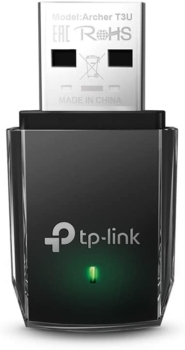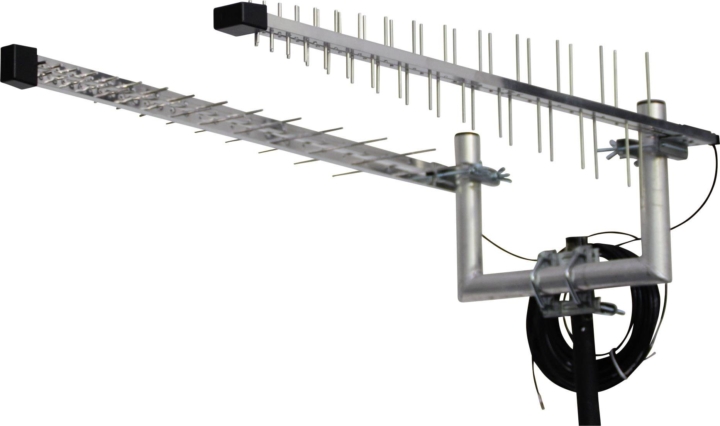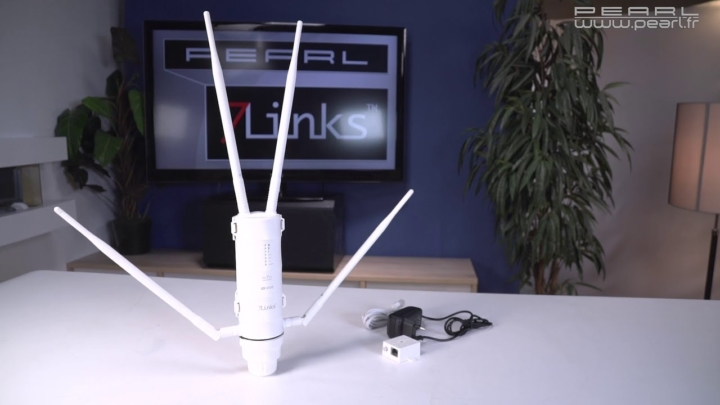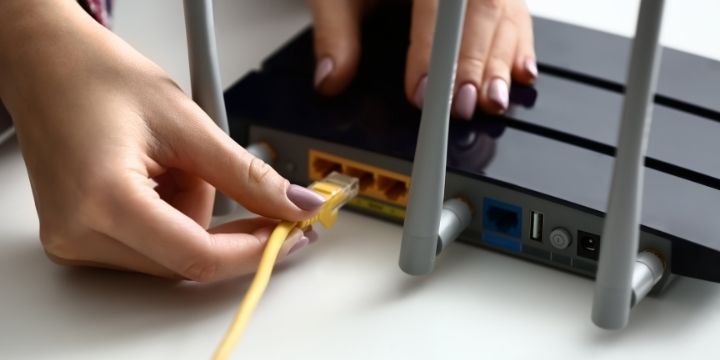If you are often faced with weak signal problems and want to get a quality connection, you definitely need a WiFi antenna. But with the plethora of models currently on the market, making the right choice is a real challenge. To shed some light on WiFi antennas and help you choose the most appropriate model, we have put together this buying guide with the best selections of the moment.
Here is our commitment, to make sure that we provide the best user experience and content quality:
You can support us by using our links to make your purchases (at no extra cost to you)! This sometimes earns us a commission which allows us to remain independent. More about us
Our selection
"This excellent value product from TP-Link is equipped with 2 high gain antennas. It is suitable for outdoor use and can transmit a signal with…"
"This TP-Link 3.0 dongle offers a total throughput of 1300 Mbps, which is ideal for those looking for a powerful and ultra-compact product. Its outstanding…"
"The powerful range and ruggedness of a Yagi directional WIFi antenna can be found in this pack of 2 Lowcostmobile 4G and 5G products. Each…"
"A high performance WiFi equipment for outdoor installation. This model features 4 very high gain omni-directional antennas providing excellent coverage up to a range of…"

This excellent value product from TP-Link is equipped with 2 high gain antennas. It is suitable for outdoor use and can transmit a signal with a range of 200m.
40,72 £ on amazonWhile the TP-Link brand has an unrivalled reputation in the WiFi antenna segment, this particular model is well worth a look. Designed for outdoor use, it offers a waterproof and robust design while being discreet. In particular, this device can withstand extreme weather conditions, over a temperature range of -30°C to 65°C. Operating on 2.4 Ghz (mono-band) and at a power of 6 dBi, it can cover a very large area and its range reaches 200 meters.
This CE, FCC and RoHS certified omni-directional model is additionally equipped with 2 high gain antennas with a transmission speed of 300 Mbps. And you can centrally manage up to 100 access points with the Omada application. In addition, the TP-Link EAP 110 is highly flexible, extremely easy to install and operates independently of electricity thanks to the Passive Power over Ethernet (PoE) support. The device supports 802.11n, 802.11b and 802.11g standards and is compatible with Windows XP, Vista, Windows 7, Windows 8 and Windows 10 operating systems.

This TP-Link 3.0 dongle offers a total throughput of 1300 Mbps, which is ideal for those looking for a powerful and ultra-compact product. Its outstanding performance makes it the best model for a smooth connection, regardless of the type of use.
14,39 £ on amazonTP-Link has combined powerful WiFi technology with an ultra-compact, portable design in this AC 1300 model, a WiFi type 3.0 USB flash drive with unparalleled data transfer speed. In fact, you have here a model with a total speed of 1300 Mbps and dual-band operation: 2.4 GHz at 400 Mbps and 5 GHz at 867 Mbps. This WiFi key is perfectly suited to the most demanding uses: from HD video broadcasting to streaming games. You can enjoy a super-fluid connection without bugs or interruptions.
But the TP-Link AC 1300 has even more advantages. For example, it is compatible with multiple operating systems: Windows 10/8.1/8-7/XP and Mac OS X 10.9/10.13 while offering advanced security through support for a high number of encryption standards (WEP, WPA, WPA-PSK, WPA2 and WPA2-PSK). And if you use a suitable MU-MIMO router, you'll get a dramatic improvement in throughput for the entire network.

The powerful range and ruggedness of a Yagi directional WIFi antenna can be found in this pack of 2 Lowcostmobile 4G and 5G products. Each model has 2 very high gain antennas, each with 9-11 dbi.
127 £ on amazonThe performance is really there with this pack of 2 Lowcostmobile WiFi directional antennas of type Yagi 4G and 5G. Suitable for indoor and outdoor use, each product is equipped with 2 antennas assembling 60 elements, each with a gain of 9 to 11 dbi, allowing to transmit a signal with unmatched efficiency. The RAD5G-ULTRA uses multiple frequency bands in the 698 MHz to 3.8 GHz range for 2G, 3G, 4G, 4G+ and 5G connections. Each antenna is equipped with 2 MIMO male SMA connectors which are compatible with 4G boxes and a large number of routers like Asus, Dlink, ZTE, Netgear, TP-Link or Huawei.
But power and great compatibility are not the only attributes of this product. Its premium aluminum design also provides excellent durability. In addition, the viewing angle is very wide on this model: 52° horizontal and 44° vertical. In addition, it comes with a WL240 type cable that minimizes losses. Note that this pack requires an installation in height with a very precise orientation for an optimal operation and it can transmit a signal on a distance of 8 to 9 km.

A high performance WiFi equipment for outdoor installation. This model features 4 very high gain omni-directional antennas providing excellent coverage up to a range of 200m.
94,40 £ on amazonThis revamped version of Wavlink's AC6OO is not only twice as powerful, but also has a more modern and attractive design. It's a perfect fit for outdoor installation thanks to its heavy-duty design that allows it to operate in extremely harsh weather conditions. With an IP 65 rating, the Wavlink AC 1200 can actually withstand a temperature range of -30°C to 70°C as well as high humidity conditions. It can operate in 3 different modes: wireless access point (LAN), WLAN repeater and router.
On the performance side, its 4 omni-directional antennas of 7 dBi each amplify the WiFi signal considerably and optimize the coverage area by extending the range up to 200 m. The AC 1200 features an extremely high data transfer rate of 1200 Mbps and supports 2 frequency bands: 2 GHz at 300 Mbps and 5 GHz at 867 Mbps. This means you can enjoy a very high-speed connection for streaming HD content or online gaming. And with Power over Ethernet (PoE) support, you can easily enjoy a powerful connection even in areas without electrical outlets.
Any specific needs?
The best high-end WiFi antenna
Your guide :
Rate this buying guide :By rating this buying guide, you are helping us to reward our best writers. Thank you!
| THE BEST | CHEAP | TOP OF THE LINE | EXCELLENT | |

In accordance with our commitment, this buying guide does not contain any sponsored products. |
 9/10 |
 8/10 |
 8/10 |
 9/10 |
| OUR SELECTION |
TP-Link EAP 110
|
TP-Link Archer T3U AC1300 - WiFi USB stick
|
LowcostMobile RAD5G-ULTRA-7003800
|
WAVLINK AC1200
|
|
This excellent value product from TP-Link is equipped with 2 high gain antennas. It is suitable for outdoor use and can transmit a signal with a range of 200m.
|
This TP-Link 3.0 dongle offers a total throughput of 1300 Mbps, which is ideal for those looking for a powerful and ultra-compact product. Its outstanding performance makes it the best model for a smooth connection, regardless of the type of use.
|
The powerful range and ruggedness of a Yagi directional WIFi antenna can be found in this pack of 2 Lowcostmobile 4G and 5G products. Each model has 2 very high gain antennas, each with 9-11 dbi.
|
A high performance WiFi equipment for outdoor installation. This model features 4 very high gain omni-directional antennas providing excellent coverage up to a range of 200m.
|
|
|
Antenna type
|
Omnidirectional
|
USB 3.0
|
Directional
|
Omnidirectional
|
|
Usage
|
Outdoor
|
Indoor
|
Indoor and outdoor
|
Indoor and outdoor
|
|
Transmission gain/power
|
3 dbi per antenna
|
<23dBm (transmission power)
|
9 to 11 dbi per antenna
|
7 dbi per antenna
|
|
Range
|
|
|
|
|
|
WiFi band
|
2.4 GHz
|
2.4 GHz and 5 GHz
|
698 MHz to 3.8 GHz
|
2.4 GHz and 5 GHz
|
|
Ease of installation
|
|
|
|
|
|
Ruggedness
|
|
|
|
|
Help us improve this table:
Report an error, request the addition of a feature to the table, or suggest another product. Thank you for your kindness!
We spend thousands of hours each year studying the major specialized websites, analyzing products of hundreds of brands and reading user feedback to advise you on the best products.
We are a product review company with a single mission: to simplify your buying decisions. Our research and testing helps millions of people every year find the best products for their personal needs and budget.
To support us you can: use our links to make your purchases (which often earns us a small commission), share our articles on social networks, or recommend our site on your blog. Thanks in advance for your support!

Your purchase should first of all depend on the use you plan to make of your WiFi antenna, and therefore also on the field to cover. If you plan to transmit a signal from a specific point to another, a directional WiFi antenna is the ideal model. On the other hand, if you want to spread a signal evenly over 360°, the omni-directional antenna is the one you need.
Then you have to take into account two data, the transmission frequency: 2.4 or 5 GHz. If you are used to playing games or watching streaming movies, prefer dual-band models. On the other hand, for a more varied use and which requires a large coverage, a mono-band antenna of 2.4 GHz will offer you the necessary power.
These 2 directly related criteria are also of considerable importance when you buy. As the range is indeed a function of the power, the ideal is always to opt for a device that can deploy a superior range and pick up even a very weak signal.
A range of 100 m and a power of 5 dBi are the minimum characteristics required for a good connection. The amplification power of the antenna is also referred to as the gain. If it is high, the performance is excellent.
WiFi networks use 2 types of standards that you should consider before your purchase. The first standard 802.11 b/g/N which uses a frequency band of 2.4 Ghz is the most used on older devices. It has 3 variations depending on the speed of data propagation.
The 802.11g transmits a signal at 54 Mbps, the 802.11b at 11 Mbps and the 802.11N at 300 Mbps. But if you're using next-generation equipment, 802.11a operating at a 5Ghz band is the best option.
When possible, look for WiFi antennas that support PoE or Power Over Ethernet. This is a feature governed by the IEEE 802.3af and 802.3at standards linking devices on the same network through Ethernet cables.
In this sense, PoE powered antennas are not dependent on electrical power, a huge advantage especially in locations where mains power is not available. Such antennas also offer simplicity of installation and are more economical.
A WiFi antenna, whether installed indoors or outdoors has the main function of capturing the signals from your internet provider and sharing it. On the market there are different types of WiFi antennas like the USB stick (modem), the repeater or the external antennas. The external antennas have an amplifier to strengthen a network signal in a poorly covered area. Other models pick up your local network and distribute it. Those with an amplifier strengthen the signal but not as much as an antenna.
To have an optimal coverage in your home, you must first look at the location of your modem or box. Ideally, you should place it high and in the center of your apartment or house. Do not place it next to a microwave or any other magnetic device. Then set up repeaters, client mode routers or access point devices to relay the signal. Access point antennas are very good at broadcasting your signal outside.
Finally, remember to protect your network with a good password.

A directional or point-to-point or patch antenna is designed to transmit a Wi-Fi signal from one location to another, hence the name point-to-point. The data is transmitted in an oval-shaped pattern with a beam width of 30°. This equipment can have a very high power of up to 14 dBi or more.
It can also cover a very long distance, up to several kilometers. But to enjoy the optimal characteristics, it must necessarily be pointed precisely in a given direction (towards the nearest cellular antenna or following the direction of the arrow on some models).

Its main difference with the directional antenna is the ability to transmit signals to several other locations in a 360° angle without distinction. This is the most common type of antenna used for WiFi or WLAN local area networks with the ability to transmit to a large number of users scattered over an area.
An omni-directional antenna, often shaped like a rod or stick, is not designed to point in a specific direction. As a result, it does not offer high vertical or horizontal radiation. Its range is around 200 meters, especially if it is an outdoor antenna.

It is a variation of the directional antenna with remarkable power. This device can indeed send back or pick up a signal in a highly focused way over a very long range. To optimize its characteristics and obtain high power, you can point the dish very precisely in the chosen direction.
This type of antenna is designed for outdoor installation and can provide power up to 25 dbi. It also comes with a range of up to several kilometers. The parabolic antenna is among the most suitable products for rough terrain and obstacles.

It is the best known and cheapest type of antenna on the market for amplifying a WiFi signal. With a very compact design, it is the most suitable model for a nomadic connection, even in the most remote places. The WiFi dongle has a USB output that you just need to connect to your computer to get access to the Internet.
Existing WiFi sticks can now provide a high connection speed of up to 1000 Mbps, which is ideal for a very demanding connection and for several users. On the other hand, the range is less compared to other types of antennas. But it does help to secure the signal better.

A router is a gateway between your provider's internet network and your devices like computer or a smartphone. There are different types on the market like your Box (which also acts as a router) or a classic router. The latter receives the signal thanks to the cable that you connect to the back of the WAN port. The LAN connectors will allow you to share your connection locally via Ethernet cables. One of the advantages of some routers is that they have several modes and they can be transformed into a Wi-Fi antenna.
In other words, if your router has "Client Mode", you can configure it to pick up your local Wi-Fi network as a repeater. No need to connect to the WAN port. This mode will allow you to extend your Wi-Fi coverage at a lower cost if you already have the right equipment. Then, if your devices such as TV or game console have an Ethernet port, you can use the router's ports while saving on cable length for less clutter.
A WiFi antenna is installed to capture and amplify the signals present in the surroundings of your home or office. Signal amplification is one of its major differences from a WiFi repeater. It is characterized by high power, high data transfer rate and long range, in short a higher quality connection. It is capable of picking up and sending back several signals and can transmit them outside your home, sometimes over several kilometers.
A WiFi repeater is like a relay. Its main role is to duplicate the WiFi signal of your router without transforming it. Thus, contrary to some preconceived ideas, a WiFi repeater does not amplify a signal. It simply copies it. The WiFi repeater is useful in a house with several rooms where a router is installed. Each user can thus obtain a good connection wherever he is inside the house.
If you already have an access point and want to get a good connection everywhere in your house, a WiFi repeater may be sufficient. However, if you want to get a strong signal at a consistent range, even outside your house, the WiFi antenna is the best option.

Extending the range of a signal
When you are far away from a transmitter, the performance of the connection decreases. This is where the WiFi antenna comes into its own because it allows you to get a signal even over a long distance. The range generally varies from 200 meters to several kilometers.
Easy sharing of the connection
With a WiFi antenna, you can easily share the connection without having to connect the PCs with cables and thus end up with a tangle of wires that is not very aesthetic or safe. In most cases, you just need to install the antenna, outdoors or indoors depending on the model and you can start connecting right away.
Better signal amplification
One of the main advantages of a WiFi antenna is also the ability to amplify a signal, however weak it may be. More specifically, models intended for outdoor mounting, if properly positioned and installed high enough provide good results and can solve wave blockages due to particular types of constructions like concrete.
High data transfer speed
A WiFi antenna also provides a very smooth connection with a high data transfer rate. Generally, the minimum speed is 300 Mbps, which is already enough to enjoy the Internet to the full whatever the use you plan: surfing the web, watching HD videos, streaming games, etc.
Easy to install
Most WiFi antennas on the market are easy to install and you can enjoy the Internet after a few simple steps. The installation does not require any special skills. Even for directional antennas which may take a bit more time to install, you can easily get a good connection as long as they are mounted high and pointed accurately.
In our opinion, the best brands of WiFi antennas in 2022 are :
TP-Link is considered the best reference for WiFi antennas. It specializes in all categories of models, from the low to the high end and from the simple WiFi stick to the ultra-powerful outdoor antenna. Its robust and modernly designed products, offering 4G or 5G connection, are highly valued by both an ordinary user and a professional.
The Lowcostmobile brand is mainly positioned in the mid and high-end segments. It has built a strong reputation in the category of high performance directional WiFi antennas of the Yagi type. Its models stand out for their exceptional range, allowing connection over a very wide coverage.
Wavlink is among the best references in the current context. It is especially famous for the design of omnidirectional antennas with high gain and high transfer rate. The brand produces both models for outdoor installation and indoor antennas.
Bros Trend is considered a good reference in WiFi antenna design. Its specializations mainly encompass powerful mid-range USB WiFi sticks, offering excellent data transfer rates.
Besides the repeaters and routers that this American brand is known for, Netgear also develops 4G WiFi sticks that stand out both for their performance and their innovative design. Its products are mostly available in mid-range and high-end.
The diagram below will help you to get an idea of the typical prices for each price range (entry-level, mid-range and high-end).
However, more expensive does not necessarily mean better.
We therefore advise you to always consult our ranking before deciding, rather than blindly relying on price ranges.
To optimize the WiFi signal with a directional antenna
A directional antenna must be oriented towards the nearest cellular antenna. You can log on to the website of the Agence Nationale des Fréquences for more information. If your signal is still weak, adjust the orientation of the antenna in a slow and progressive way. To help you, use a tool like speedtest to quickly get the best positioning angle. For the particular case of a Yagi antenna, the arrowhead already indicates the direction of orientation
Use a mast to fix your antenna outside
A mast is not only used to securely attach your antenna, it also helps to minimize possible interference, especially if you plan to install it on a metal roof. Be sure to screw your antenna securely onto the mounting points to ensure a nearly immobile positioning.
To efficiently position the antennas of a router
Generally, internal antennas should be placed vertically, and form a 90° angle with the router. This is valid for most cases in order to get a strong signal. But in all cases you should refer to the advice given by your manufacturer. For some types of devices for example, the first antenna should be placed vertically while the second horizontally for a good signal polarization.
Secure your WiFi access
If too many users connect on the same network, it will inevitably result in lower throughput. So, to optimize the connection, consider securing your signal by using a high security level password. Other tricks include disabling the visibility of your signal to external users or reducing its range by changing the channel value.
To improve the speed or range of a WiFi antenna
If you've already chosen a high location and your WiFi signal is still weak, check that your antenna is pointed at the nearest relay or following the signal emitted by the equipment. Then, try to place it in a way to clear the view, especially avoiding metal constructions as much as possible, especially if it operates on a 5 GHz frequency which is very sensitive to obstacles. It is also possible to optimize the configuration by choosing channels specified by the manufacturer in case of strong interference.
First, you need to install the device driver, normally delivered with the WiFi key on your computer. If you are using Windows 10, your PC may automatically detect the stick without any installation being required. After restarting your computer, connect the antenna via a USB port on the PC. You can choose between several outdoor locations: on the roof, on the terrace, on a high pole or even on the front of your house as long as the antenna is placed high enough. Indeed, this position is necessary to minimize possible disturbances due to obstacles. And if you can't position your antenna outside, install it on the top floor of your house, near a window or in the attic.
Obstacles such as dense forests, metallic or concrete constructions can considerably degrade the signal emitted by your WiFi antenna. The best thing is to have as much as possible a clear view between the transmitter and the receiver of the signal, hence the need for positioning in height. But appliances like microwave ovens too, especially if they are less than 7m away from your router, will have a negative impact on the quality of your signal.
A single WiFi antenna connected to a router is equivalent to a single data stream. So if 2 antennas are working on the router, the stream is logically doubled and the data transfer rate as well. Concretely, with a router using 2 antennas, you can get a 300 Mbps data rate in all rooms of your house while you will only reach this speed if you are very close to your router if it works with a single antenna.
Every month we help more than 1 000 000 people buy better and smarter.
Copyright © 2022 - Made with ♥ by buyingbetter.co.uk
Your reviews and buying guides 0% advertising, 100% independent!